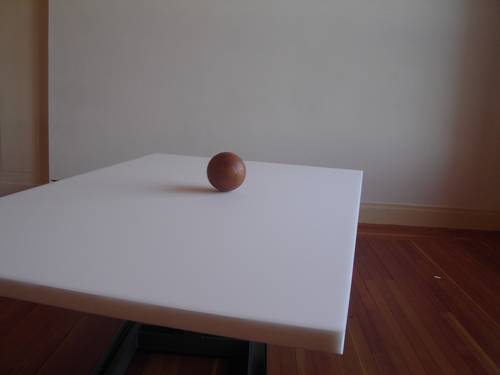REVIEW: RUNDLEDERWELTEN (FOOTBALL : ART) MARTIN-GROPIUS-BAU PUBLISHED IN CONTEMPORARY NO. 82, JUNE 2006

The exhibition had many representations of the game, from large format photographs of football fields by Andreas Gursky, to 'Kaiser' Franz Beckenbauer participating in a one minute sculpture by Erwin Wurm, as well as several portraits of the 1974 German winning team by the likes of Werner Büttner, Volker Schrank and Andy Warhol, amongst others. There were Paul Smith's photographs of Robbie Williams as multiple football players (as seen on the cover of Williams album Sing When You're Winning (2000)) and a opportunity for some target practice with a soft ball as a part of Olaf Nicolai's Camouflage / Torwand 1-3 (Croft, Fleft, Maier) (2001). Michael Staab's Organisation – Büro for Desinformation (2005) mainly reminded me of the fact that if Norway had beaten the Czech Republic in the play-off last autumn, it would have been us playing in Leipzig this summer.
Germany are already World Champions, and I do not mean in their heads or metaphorically speaking. Their woman's team is the best in the world. This is celebrated in the exhibiton in insanely expensive 20:1, laser carved, 3D bodyscans of the woman's team by Karin Sander. For whatever reason, they take up greater part of a room. So does Till Velten's more or less social-anthropological project Mannschaft (2005), where he, ironically I hope, tries to find out if women football players are like other football players. In Oliver Sieber's portrait series 11 Freundinnen... (2002) the aim is to point out the infividuality of team members. It fails. They are just indistinctive portraits of young girls.
The 2006 World Championship is a matter of national pride for Germany. As a sort of joke, there are 74 artists and artists groups involved in this exhibition, most of them born in a German-speaking country. There is an understandable reason for this. The curator is German speaking, as is the main audience. Also, almost every artist has done something dealing with football one time or another. Doing world wide research would be such a waste
'Rundlederwelten' kill most of the artwork by taking it out of its original context and attempting to make a theme park. As is the curse with many large themed exhibitions, the pieces that might be good lack the space to breathe. But there are glimpses of light. In Robin Rhode's digital animation, Hondje (2001), four male youths in an urban lot pretend to do tricks and balance a ball – a ball that is actually several drawings on the wall behind them. This si an interesting way of reminding us about the fact that football was and, to a certain degree, still is a proletarian sport. There are some others, like Thomas Virnich's Colosseum (the audience will be larger, the more the stadium shrinks) (1994 – 2005) which makes a good point about the history of the stadium, but the only great piece is the one by Serge Spitzer. In his Global Culture (2004 – 2005) a (foot)ball balances of a table. As it rolls in one direction, the table moves in te opposite direction. The ball never falls off. Daniel Birnbaum called it a masterpiece; I concur.
photo:
Serge Spitzer
Global Culture
2004-2005
Automatic rotating table, football, 100 x 260 x 160 cm
Courtesy of the artist
© sergespitzerstudio new york
